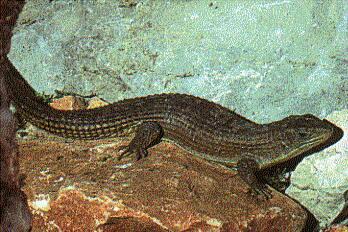Sudan Plated Lizard
Scientific Name: Gerrhosaurus major
Sun, 6th July, 2025 - 3:20 am GMT
Sponsor Ads:

Alternative Name
Scientific Name: Gerrhosaurus majorBasic Info
The Sudan Plated Lizard averages around 18 inches in length, with half that length being its tail. They range between 16 and 28 inches when full-grown. The Sudan Plated Lizard has a very strong, muscular body that is slightly flat. Their legs are small relative to their body size. The scales of the Sudan Plate Lizard have raised ridges (keels) on the dorsal surface scales and are smooth elsewhere. The Sudan Plated Lizard can be found in almost all shades of brown, from yellow to quite dark, and often have lighter markings.
Health
Captive Sudan Plated Lizards should be provided with a large enclosure with an area to swim in and substrate deep enough to burrow. The temperature within the enclosure should average around 85 degrees during the daytime and about ten degrees cooler at night. Sudan Plated Lizards can be fed insects such as crickets, worms, small mice, and some fruits and vegetables. Sudan Plated Lizards eat more vegetation than other species of Plated Lizards. Breeding Sudan Plated Lizards will breed in the spring, after a four to six week period of cooler temperatures. After mating, the female will lay a clutch of between two and six eggs. They are rarely bred in captivity.Habitat
Found in southern AfricaBehavior
The Sudan Plated Lizard is a timid animal found in Africa. Although naturally shy, this lizard can easily be acclimated to the company of humans. They are a moderately sized animal and make an excellent pet for a lizard-lover. Found primarily in relatively dry climates, the Sudan Plated Lizard can sometimes be seen retreating into the burrows, mounds and nests of other creatures. They generally live in regions that are rocky and do not have much vegetation. They spend most of their time hidden underground to avoid the hot desert sun, a habit that reinforces their shy personality. They are diurnal animals, meaning they do most of their hunting during the day. When threatened, the Sudan Plated Lizard usually hides. If threatened they will use their tail as a weapon. This is beneficial not only because the tail is very heavy and can cause a lot of harm to the attacker, but also because if the tail is broken off it can be regenerated. In captivity, the Sudan Plated Lizard will become tolerant of handling. When creating an enclosure for the Sudan Plated Lizard it is important to bear in mind that these lizards do climb, and they should be given ample climbing room. The average Sudan Plated Lizard will live between seven and twelve years.Origin
AfricaHistory
While numerous varieties of lizards are kept in captivity, the Sudan Plated Lizard is one of the best choices. They are interesting to watch, tame easily, and taking care of them is not difficult. In the wild, they are found in southern Africa. Sudan Plated Lizards are rarely bred in captivity and most available captive Plated Lizards were wild-caught. As with other reptiles, captive-bred Sudan Plated Lizards are more likely to be healthy and are generally more docile than wild-caught animals.Common Foods
In the wild, Sudan Plated Lizards feed primarily on insects, although they are omnivorous. They will eat fruits, vegetables, insects and small rodents.Sponsor Ads:
Romance, like the rabbit at the dog track, is the elusive, fake, and never attained reward which, for the benefit and amusement of our masters, keeps us running and thinking in safe circles. --Beverly Jones
Sudan Plated Lizard
Coded by: BGID® | ALL RIGHTS RESERVED Copyright © 2000-2025
Disclaimer | Privacy | Report Errors / Contact | Credits

 Why haven't we as a collective earth met with aliens yet?
Why haven't we as a collective earth met with aliens yet?  World EcoSystem - Biodiversity Changes - Who is on board and who isn
World EcoSystem - Biodiversity Changes - Who is on board and who isn  Homosexual behavior stems from the mind or genetics?
Homosexual behavior stems from the mind or genetics?  The Best Text Adventure You Will Ever Play! The official site:
The Best Text Adventure You Will Ever Play! The official site:  Mouthwash - Mouthrinse - Mouth Sores - Healing Infections - Gingivitis
Mouthwash - Mouthrinse - Mouth Sores - Healing Infections - Gingivitis  Treatment for Depression
Treatment for Depression  Ultra radical and violent Islamist group that even rivals Al Qaeda
Ultra radical and violent Islamist group that even rivals Al Qaeda  An idea to have teachers who want to carry guns to school undergo some level of police training will be left up to local school districts and police departments.
An idea to have teachers who want to carry guns to school undergo some level of police training will be left up to local school districts and police departments.